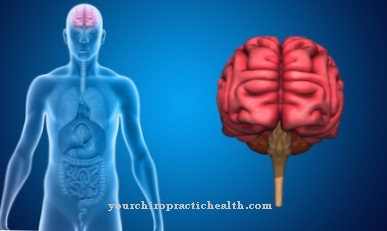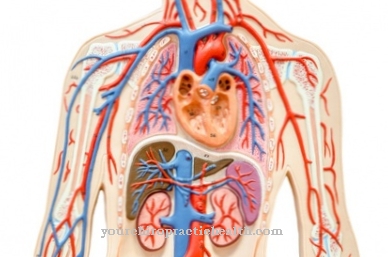Of the Sleep rhythm is the cyclical sequence of sleep phases in which phases of light sleep are followed by regular phases of deep sleep and several of the so-called non-REM stages are each completed by a REM phase in which a large part of the dream happens.
Using the sleep rhythm, the brain uses neurophysiological processes to ensure that the sleeper does not wake up prematurely and that sleep can therefore last longer until a state of recovery is achieved.
The smallest deviations from the natural sleep rhythm can make sleep less restful and make those affected feel daytime sleepiness or lack of energy, whereby various disturbances of the sleep rhythm may even give an indication of specific sleep disorders such as narcolepsy or even other diseases such as heart failure.
What is the sleep rhythm?

The cyclical process in which a person's sleep phases alternate is also called the sleep rhythm or sleep cycle. In addition to the sleep phase, the different stages of sleep include the light sleep phase, the two deep sleep phases and REM sleep, which is primarily used for dream activity and information processing. All stages except REM sleep are also known as non-REM sleep.
While the person sleeps, phases of deep sleep alternate with individual phases of light sleep at specific time intervals. This variation in the depth of sleep is controlled by the brain, which in this way ensures that the state of sleep is maintained.
After falling asleep, the sleep process is subject to neurophysiological control. Towards the end of sleep, the individual sleep phases alternate at ever shorter intervals. The sleep rhythm changes according to the personal sleep quota until the sleeper wakes up.
A distinction must be made between the term sleep rhythm and the expression of the sleep-wake rhythm, which corresponds to the cyclical sequence of wake and sleep parts per day.
Function & task
The cycles of sleep and the sleep rhythm in which the person enters them ensure sleep through the night. During sleep, the organs and cells of the body regenerate, but the psyche also regenerates and experiences and learned things are processed. For these reasons, sleep is vital for humans and the neurophysiological sleep rhythm is used to ensure this vital process.
A healthy person goes through around four to seven sleep cycles each night, each lasting around 70 to 110 minutes. This sleep rhythm is also known as ultradian rhythm. It lets the sleeper go through the non-REM stages N1, N2 and N3 followed by a repetition of stage N2. The repetition of the N2 stage is regularly followed by a REM phase.
The more cycles the sleeper experiences, the more the deep sleep phase of these cycles decreases. In late cycles, for example, the sleeper usually no longer reaches any deep sleep phases at all, while the REM percentage increases in the morning hours.
A healthy adult sleeps around five percent of the night in stage N1, up to 55 percent in stage N2 and up to 25 percent in stage N3. REM sleep also accounts for up to 25 percent of daily sleep, with the waking portion totaling around five percent.
The values for the individual stages can be recorded using polysomnography and help to create a sleep profile. Each sleep phase differs from the other in the speed of the pulse rate, breathing and brain wave activity. Therefore, by monitoring these and similar parameters, sleep laboratories can assess which sleep phase a patient is currently in.
You can find your medication here
➔ Medication for sleep disordersIllnesses & ailments
While the required sleep duration can vary from person to person, the sleep pattern in terms of the sleep rhythm and the respective sleep stages remains the same regardless of personal sleep volume. Clear and chronic deviations from the natural sleep rhythm automatically make sleep less restful. Those affected often feel sleepy or exhausted, lacking energy and unable to concentrate the next morning.
In the meantime, medicine also assumes that the sleep rhythm influences certain eating habits. The various symptoms as a result of a disturbed sleep rhythm can already occur when the stages change only minimally in their sequence.
A strong deviation from the percentages of the sleep stages can under certain circumstances have a disease value. The same applies to interruptive wake-up reactions, which occur particularly in sleep apnea syndrome. In this disease, tiny respiratory arrests occur during sleep, which are usually caused by extreme relaxation of the upper airways.
For many other sleep disorders, however, REM sleep that begins too early is also characteristic. REM stages shortly after falling asleep are also known as sleep onset REM periods, for example. These phenomena can be an indication of narcolepsy, that is to say of sleeping sickness, to the sleep doctor.
In some cases, premature onset of REM sleep also occurs in the course of sleep apnea syndrome. The sleep doctor decides which sleep disorder is actually present by analyzing the entire sleep profile.
For the first time, modern studies have also been able to document a connection between cardiac function and sleep rhythm. For example, the sleep rhythm of people with chronic heart failure differs significantly from the sleep rhythm of those with a healthy heart. Cardiac dysfunctions can result, for example, as a reduced proportion of REM sleep or a generally reduced proportion of light sleep. There is also a connection between sleep patterns and alcohol consumption. The waking phases of alcoholics should clearly exceed the natural share of five percent.




























